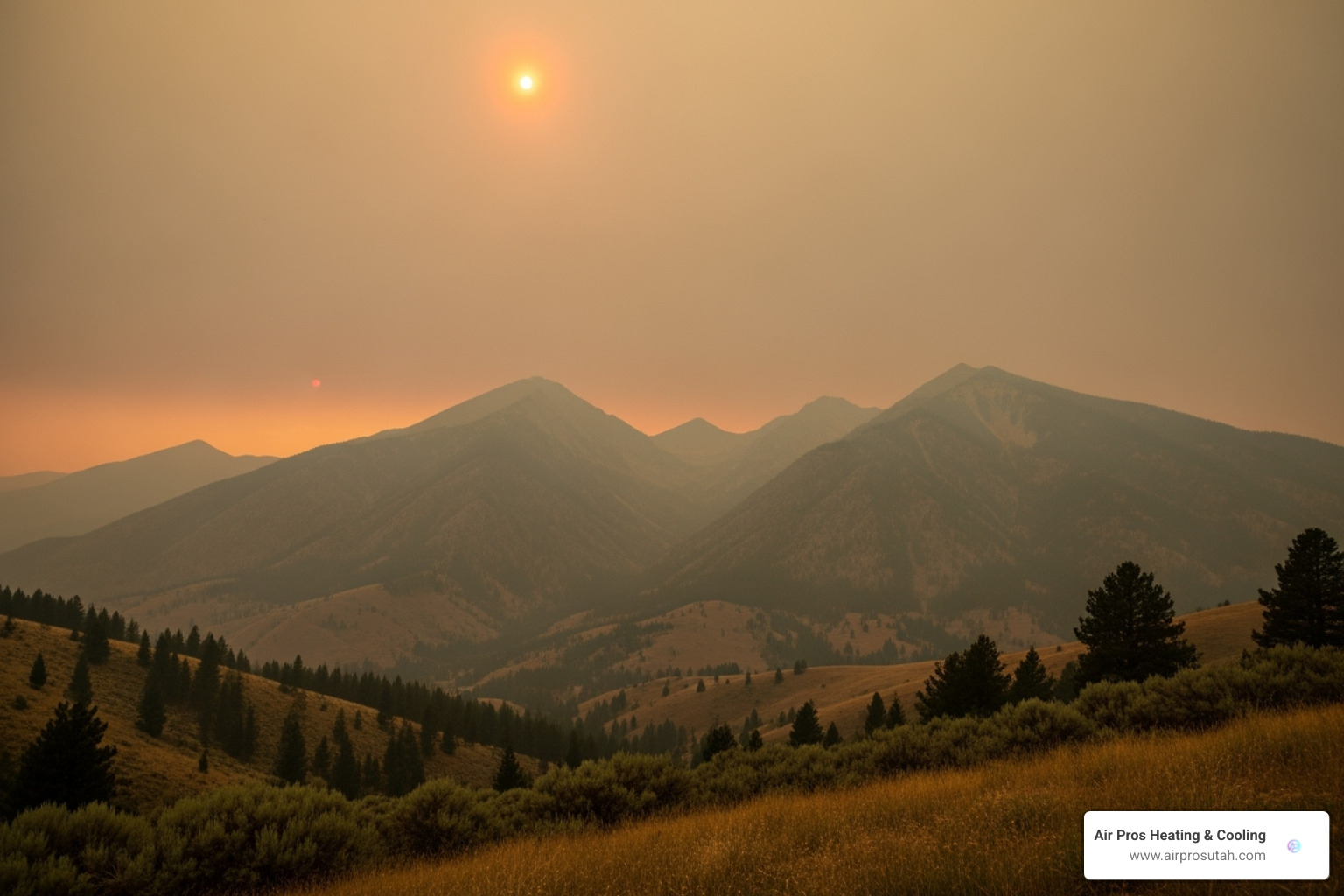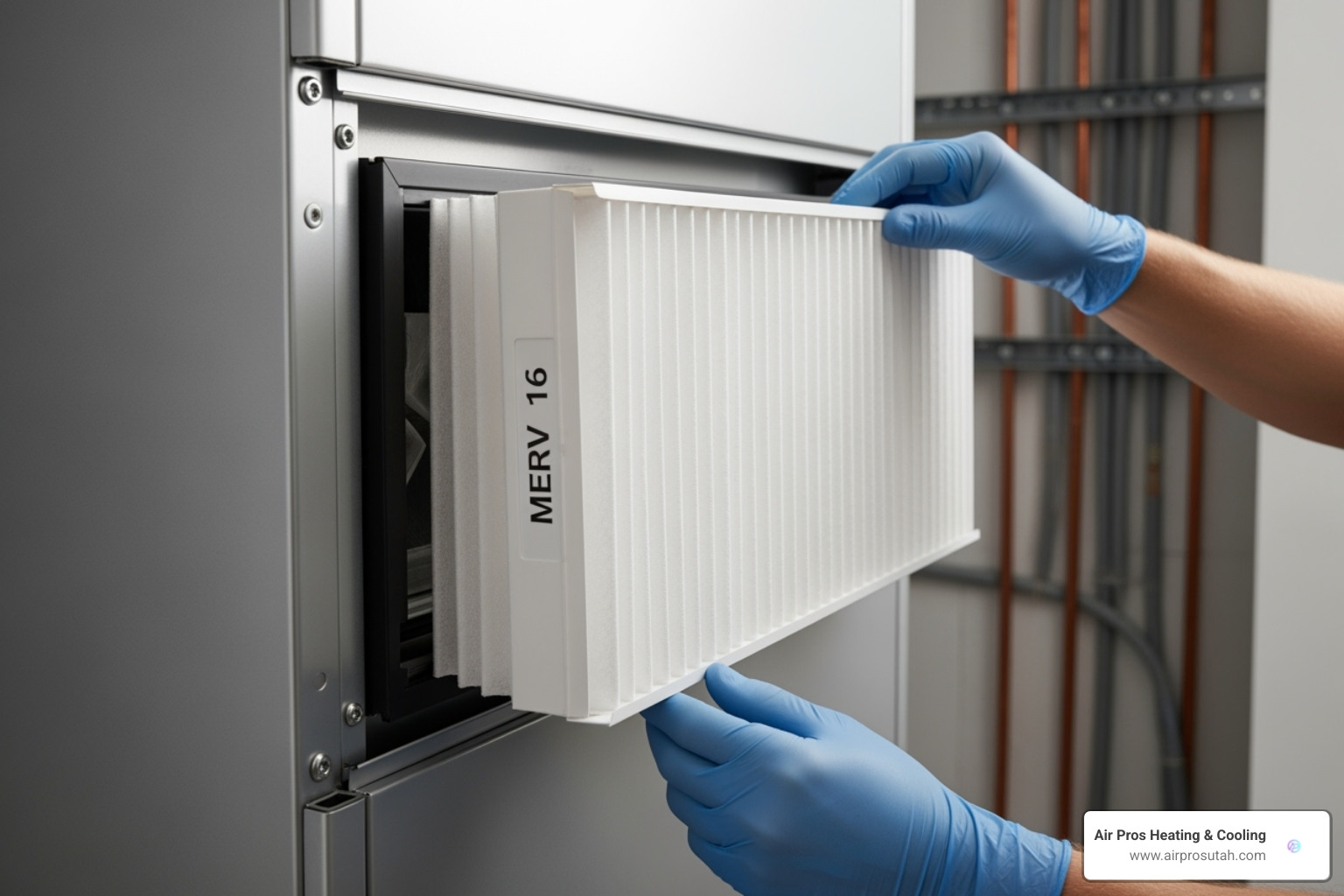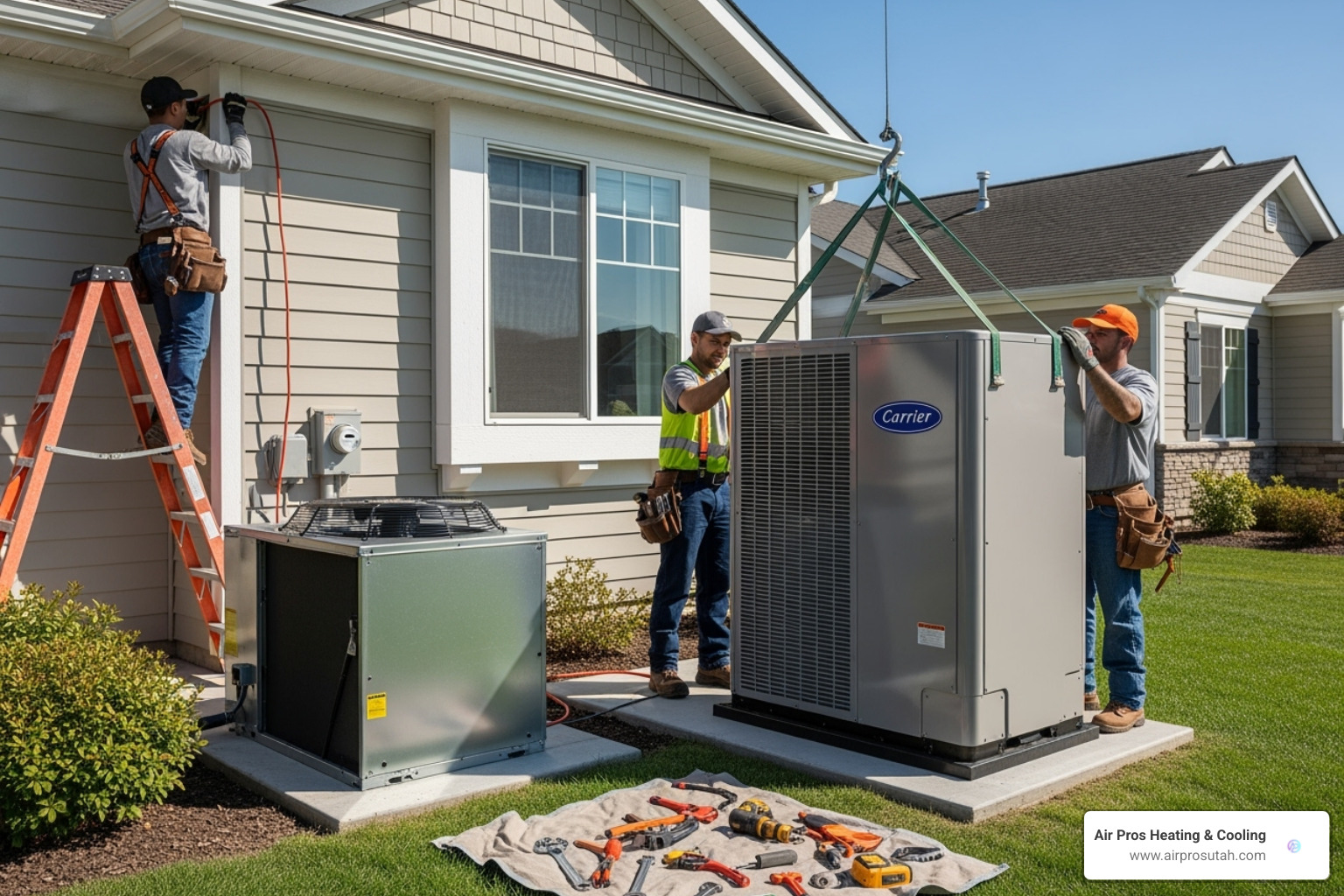
Utah's Indoor Air Quality Explained: Don't Hold Your Breath
Why Utah's Indoor Air Quality Deserves Your Attention
Indoor air quality Utah residents experience can be up to five times more polluted than outdoor air. In a state known for winter inversions and wildfire smoke, that's a serious concern, especially since most people spend over 90% of their time inside.
Key Facts About Indoor Air Quality in Utah:
- Wildfire impact: Smoke infiltrates homes at 78% of outdoor pollution levels.
- Inversion effect: Winter inversions contribute 30% of outdoor pollution indoors.
- Health risk: Poor indoor air most affects children, the elderly, and those with respiratory conditions.
- Common pollutants: VOCs, radon, dust, mold, and combustion gases.
Utah's unique geography, with mountains trapping pollutants in valleys, creates a perfect storm for air quality issues. While modern, energy-efficient homes save on utility bills, they can also trap these pollutants without proper ventilation.
The good news is that you have direct control over your indoor air. Simple changes to your HVAC system and daily habits can dramatically improve what your family breathes.
I'm Alex Wiltz, founder of Air Pros Utah Heating & Cooling. My hands-on experience with Utah's unique air quality challenges has shown me that the right combination of technology and habits can transform your home's air and your family's health.

Indoor air quality Utah terms explained:
Why Indoor Air Quality is a Major Concern in Utah
Utah's beautiful landscape presents unique air quality challenges. While we worry about outdoor haze, the air inside our homes can be far more polluted. Since we spend over 90% of our time indoors, this is a major health concern.
Our mountains trap pollutants in the valleys, especially during winter inversions. This smoggy air inevitably finds its way into our homes. Summertime brings wildfire smoke, carrying tiny PM2.5 particles that easily slip indoors. Higher ozone levels also form when pollutants mix with sunlight, making breathing difficult for some.
The EPA ranks indoor air pollution as a top environmental risk. It's especially dangerous for children, the elderly, and those with asthma or allergies. Long-term exposure can lead to chronic respiratory issues, heart problems, and even cancer. Understanding these risks is the first step to creating a healthier home.
Wildfires vs. Inversions: How Outdoor Events Uniquely Impact Your Home

Not all outdoor pollution affects our homes equally. Research from the University of Utah shows how different pollutants sneak inside.
Wildfire smoke, composed of tiny PM2.5 particles, is a major threat. These particles easily get deep into your lungs. Studies show that during a wildfire, your indoor air pollution can be about 78% of what's outside. The particles are resilient and slip through tiny cracks and even HVAC systems.
During a winter inversion, much of the pollution is ammonium nitrate. Inside your warmer, drier home, these particles tend to turn into a gas, which means indoor pollution levels are typically only about 30% of what they are outside. While better than wildfire smoke, it's still a significant impact.
Dust particles are usually larger and easier for your home's filters to catch. Fireworks also release particles, impacting indoor air at a rate similar to inversions (about 30%). Understanding these differences helps us improve the indoor air quality Utah homes need. You can learn more from this Scientific research on outdoor pollution's effect on indoor air.
Common Indoor Pollutants Found in Utah Homes
Many serious threats to your air quality originate inside your home. Knowing what they are is the first step to cleaner air.
- Volatile Organic Compounds (VOCs): Gases from paints, cleaning supplies, air fresheners, and furniture. Indoor levels can be up to 10 times higher than outdoors.
- Radon Gas: An invisible, odorless radioactive gas from the natural breakdown of uranium in soil. It can seep into homes through foundation cracks and is a leading cause of lung cancer for non-smokers. We encourage you to Check for radon in your home.
- Particulate Matter (PM): Besides outdoor sources, tiny particles are generated by cooking, burning candles, and stirring up dust and pet dander.
- Pet Dander: Tiny flakes of skin shed by animals that can trigger allergies and asthma.
- Dust Mites: Microscopic creatures in beds and carpets that are a major trigger for allergies and asthma.
- Mold and Mildew: Grows in damp areas like leaky pipes or high-humidity spots, releasing spores that cause allergic reactions.
- Combustion Gases: Pollutants like nitrogen oxides and carbon monoxide from gas stoves, fireplaces, or other fuel-burning appliances. Carbon monoxide is especially dangerous as it's odorless and can be deadly.
- Cleaning Product Chemicals: Harsh chemicals that become airborne and can irritate your eyes, skin, and respiratory system.
- Secondhand Smoke: A mix of harmful chemicals and particles that linger long after a cigarette is extinguished.
Practical Solutions for Better Indoor Air Quality in Utah
You have more control over your home's air than you think. Improving indoor air quality Utah homes need is about three approaches: ventilation (fresh air in, polluted air out), source control (stopping pollutants at the source), and air cleaning (filtering what's there). You can start with small changes, like upgrading your HVAC filter, and build from there. What matters is taking the first step toward cleaner air for your family.
The Role of Your HVAC System in Utah's Indoor Air Quality

Your HVAC system is the lungs of your home and your first line of defense for clean air. The key is its air filter, but not all are created equal.
Standard 1-inch filters only protect your equipment from large debris, letting harmful small particles pass through. Upgrading to a MERV 11 or 13 filter can capture up to 85% of these tiny pollutants, a huge improvement over the 20% a basic filter might catch. For the ultimate in filtration, HEPA filters remove 99.97% of particles, though most residential systems can't handle them without modification. Regular filter changes (every 1-3 months) are essential for any filter to work effectively. For tips, see our guide on Affordable HVAC Maintenance.
For more advanced cleaning, consider these options:
- Whole-home air purifiers actively scrub pollutants from the air in every room.
- UV germicidal lights, installed in your air handler, neutralize bacteria, viruses, and mold spores. Learn more in our article on UV Light Systems for HVAC Health.
- Humidity control is vital in Utah's dry climate. Whole-home humidifiers maintain optimal humidity (30-50%), reducing respiratory irritation, while dehumidifiers prevent mold in damp areas.
Your HVAC system is about more than comfort; it's about creating a healthy home environment.
Advanced and Personalized Comfort Solutions
For homes with comfort challenges or family members with different needs, advanced solutions like zoned climate control and ductless mini-split systems are game-changers.
At Air Pros, we specialize in ductless mini-split systems because they provide personalized comfort and air quality control. Instead of one temperature for the whole house, you can customize conditions room by room. This zoned approach saves energy and money by only heating or cooling the spaces you're using.
For indoor air quality Utah families need, the biggest benefit is the multi-stage filtration at each indoor unit. Each mini-split actively cleans the air in its specific zone, removing dust, pollen, and other particles right where it matters most. This is life-changing for those with allergies or sensitivities, allowing you to create a clean-air sanctuary in a bedroom or home office.
These systems are ideal for home additions, remodels, or any situation where you want precise control over your environment. Explore our Ductless Mini-Split Services to see how they could transform your home.
Everyday Habits for Cleaner Indoor Air

Simple, daily habits can significantly improve your indoor air quality Utah without costing a dime.
- Ventilate When Cooking: Cooking, especially frying, creates significant indoor pollution. Always run your exhaust fan and consider cracking a window.
- Choose Low-VOC Products: Many cleaning supplies, air fresheners, and paints release Volatile Organic Compounds (VOCs). Look for "low-VOC" or "no-VOC" labels. The EPA Safer Choice program helps identify healthier products.
- Clean Smarter: Use a HEPA-filtered vacuum to capture tiny particles instead of recirculating them. Mop and dust with damp cloths to trap dirt.
- Manage Humidity: Keep indoor humidity between 30-50% to prevent mold and discourage dust mites. Use exhaust fans in bathrooms and kitchens.
- Avoid Indoor Burning: Skip the wood-burning fireplace on Mandatory Action days when outdoor air is already poor.
- Remove Shoes at the Door: This simple habit prevents outdoor pollutants like dirt, pesticides, and lead from being tracked into your home.
Utah-Specific Resources and Programs
Improving indoor air quality Utah is a collective effort, and numerous state and local resources are available to help residents. These initiatives provide valuable monitoring tools, health guidance, and energy-saving programs.
State and Local Government Resources
Several agencies offer data and guidance to empower residents.
- The Utah Division of Air Quality (DAQ) is your go-to source for real-time air quality data and forecasts. Their website, the DEQ Home, offers detailed reports and educational materials.
- The UtahAir App (for Android and iOS) provides hourly updates, forecasts, and health advisories to help you make informed decisions about outdoor activities.
- Local programs, like Salt Lake County's Green and Healthy Homes initiative, focus on creating healthier and more energy-efficient living environments. In the past, Salt Lake City has offered programs providing free filters and purifiers to eligible residents.
- The UCAIR initiative (Utah Clean Air Partnership) is a non-profit dedicated to improving air quality through public education and community engagement. Learn more at the UCAIR website.
Health and Energy Programs for Residents
Several programs support residents with health concerns and offer incentives for energy-efficient home improvements that also boost indoor air quality.
- The Utah Department of Health provides essential information on the health impacts of air pollution, with specific guidance for sensitive groups. Find support for conditions like asthma on their Asthma resources page.
- Dominion Energy's Thermwise program offers rebates for energy-saving upgrades like high-efficiency furnaces and better insulation. These improvements create a more consistent indoor climate and reduce the infiltration of outdoor pollutants.
- Rocky Mountain Power's Wattsmart program provides incentives for energy-efficient upgrades like better windows and insulation. A tighter home envelope means less uncontrolled air leakage, helping you manage your indoor air quality Utah.
Frequently Asked Questions about Indoor Air Quality in Utah
We get a lot of questions from Utah families about indoor air quality Utah homes deal with. Here are the most common concerns and our straight answers.
How can I test the air quality in my home?
You don't have to guess what's floating around in your home's air. There are several ways to get a clear picture, depending on what you're looking for and how detailed you want to get.
For everyday monitoring, consumer-grade indoor air quality monitors are your best friend. These handy devices can track the stuff that matters most - like PM2.5 (those tiny particles from wildfire smoke), VOCs from cleaning products or new furniture, plus temperature and humidity. Brands like PurpleAir offer monitors that give you real-time readings, so you can actually see how cooking dinner or lighting a candle affects your air quality. It's pretty eye-opening!
Radon testing is a different beast entirely. Since this radioactive gas is completely odorless and tasteless, you need specialized test kits. The good news? The Utah DEQ makes it easy to get these kits and walks you through the whole process. Given that radon is the leading cause of lung cancer in non-smokers, this test is definitely worth doing.
When you need the full picture - maybe you're dealing with persistent allergies, suspect mold, or just want a comprehensive baseline - professional testing is the way to go. These experts use specialized equipment that can identify a much wider range of contaminants and give you detailed recommendations for fixing any problems they find.
What is the best type of air filter for a Utah home?
Here's where a simple upgrade can make a huge difference in your indoor air quality Utah style. Most homes come with basic filters that barely do the job - think of them as catching only the big stuff while letting everything else sail right through.
For Utah homes dealing with wildfire smoke and winter inversions, we recommend stepping up to a pleated filter with a MERV rating between 11 and 13. Here's why this sweet spot works so well:
These filters are game-changers when it comes to catching those tiny particles that make our air unhealthy. While your basic filter might only grab about 20% of small particles, a MERV 11-13 filter captures up to 85% of them. That includes the PM2.5 particles from wildfire smoke that love to sneak into our homes.
But here's the thing - you don't want to go overboard. Filters with super-high MERV ratings can actually choke your HVAC system, making it work harder and potentially shortening its life. The 11-13 range gives you excellent air cleaning without stressing your equipment.
Always check your system's manual before upgrading, or give us a call if you're not sure what your system can handle. And remember - the best filter in the world won't help if it's clogged, so change it every 1-3 months, or more often when the air outside is particularly nasty.
Are portable air purifiers effective during a wildfire or inversion?
Absolutely. Portable air purifiers with HEPA filters are extremely effective during Utah's challenging air quality events. A true HEPA filter captures 99.97% of fine particles, including the PM2.5 that makes smoke and inversion pollution so dangerous. By running a portable purifier in a bedroom or main living area, you can create a "clean air room" in your home. This provides a safe haven, especially for children, the elderly, or anyone with respiratory issues. They are a great supplement to your main HVAC system's filtration.
Take Control of Your Home's Air Today
Improving your home's indoor air quality Utah is a vital step for your family's health and comfort. While Utah's environmental challenges can feel daunting, you have significant control over the air inside your home.
Start with simple changes: swap your HVAC filters regularly, use your kitchen exhaust fan, and choose low-VOC products. These habits make a real difference.
For lasting results, a professional partner can help. At Air Pros Utah, we are your allies in creating a healthier home environment. Our team of HVAC Experts in Salt Lake City has the knowledge to tailor the right solutions for your home's specific needs.
Whether you're considering high-efficiency air filtration, a whole-home purifier, or our specialized ductless mini-split systems for personalized clean air zones, we're here to guide you. Take the next step towards cleaner air. For a comprehensive assessment of advanced solutions, please schedule a heat pump installation consultation with us. Let's work together to make your home a sanctuary of fresh, clean air.


